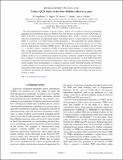| dc.contributor.author | Engelhardt, M. | |
| dc.contributor.author | Musch, B. U. | |
| dc.contributor.author | Hagler, P. | |
| dc.contributor.author | Negele, John W. | |
| dc.contributor.author | Schafer, A. | |
| dc.date.accessioned | 2016-03-02T17:20:48Z | |
| dc.date.available | 2016-03-02T17:20:48Z | |
| dc.date.issued | 2016-03 | |
| dc.date.submitted | 2015-07 | |
| dc.identifier.issn | 2470-0010 | |
| dc.identifier.issn | 2470-0029 | |
| dc.identifier.uri | http://hdl.handle.net/1721.1/101406 | |
| dc.description.abstract | The three-dimensional momenta of quarks inside a hadron are encoded in transverse momentum-dependent parton distribution functions (TMDs). This work presents an exploratory lattice QCD study of a TMD observable in the pion describing the Boer-Mulders effect, which is related to polarized quark transverse momentum in an unpolarized hadron. The primary goal is to gain insight into the behavior of TMDs as a function of a Collins-Soper evolution parameter, [^ over ζ], which quantifies the rapidity difference between the hadron momentum and a vector describing the trajectory of the struck quark, e.g., in a semi-inclusive deep-inelastic scattering (SIDIS) process. The lattice calculation, performed at the pion mass m[subscript π] = 518 MeV, utilizes a definition of TMDs via hadronic matrix elements of a quark bilocal operator with a staple-shaped gauge connection; in this context, the evolution parameter is related to the staple direction. By parametrizing the aforementioned matrix elements in terms of invariant amplitudes, the problem can be cast in a Lorentz frame suited for the lattice calculation. Aided by the lower mass of the pion, compared to the nucleon studied previously, the present investigation of pion TMD observables constitutes an important step towards the quantitative study of the physically important regime of large relative rapidity where the dependence on [^ over ζ] appears to approach a limit. Although matching to perturbative evolution equations in [^ over ζ] is not yet available, extrapolations based on Ansätze containing inverse powers of [^ over ζ] yield stable results with an uncertainty as low as 20%, and both upper and lower bounds for the asymptotics are obtained. In passing, the similarity between the Boer-Mulders effects extracted in the pion and the nucleon is noted. | en_US |
| dc.description.sponsorship | United States. Dept. of Energy (Grant DE-FG02-94ER40818) | en_US |
| dc.publisher | American Physical Society | en_US |
| dc.relation.isversionof | http://dx.doi.org/10.1103/PhysRevD.93.054501 | en_US |
| dc.rights | Article is made available in accordance with the publisher's policy and may be subject to US copyright law. Please refer to the publisher's site for terms of use. | en_US |
| dc.source | American Physical Society | en_US |
| dc.title | Lattice QCD study of the Boer-Mulders effect in a pion | en_US |
| dc.type | Article | en_US |
| dc.identifier.citation | Engelhardt, M., P. Hagler, B. Musch, J. Negele, and A. Schafer. “Lattice QCD Study of the Boer-Mulders Effect in a Pion.” Phys. Rev. D 93, no. 5 (March 1, 2016). © 2016 American Physical Society | en_US |
| dc.contributor.department | Massachusetts Institute of Technology. Center for Theoretical Physics | en_US |
| dc.contributor.department | Massachusetts Institute of Technology. Department of Physics | en_US |
| dc.contributor.mitauthor | Negele, John W. | en_US |
| dc.relation.journal | Physical Review D | en_US |
| dc.eprint.version | Final published version | en_US |
| dc.type.uri | http://purl.org/eprint/type/JournalArticle | en_US |
| eprint.status | http://purl.org/eprint/status/PeerReviewed | en_US |
| dc.date.updated | 2016-03-01T23:00:07Z | |
| dc.language.rfc3066 | en | |
| dc.rights.holder | American Physical Society | |
| dspace.orderedauthors | Engelhardt, M.; Hagler, P.; Musch, B.; Negele, J.; Schafer, A. | en_US |
| dc.identifier.orcid | https://orcid.org/0000-0002-5713-0039 | |
| mit.license | PUBLISHER_POLICY | en_US |
